Fact in Fiction
/Attention to detail and accuracy is what marks the difference between the hobbyist and the professional. And some of us actually enjoy the research.
Read MoreInternational Award-Winning Author
Attention to detail and accuracy is what marks the difference between the hobbyist and the professional. And some of us actually enjoy the research.
Read MoreWhen Frederick Douglass spoke at an anti-slavery convention in 1841, he was part of pattern in history, the Power of '41.
Read MoreThese two members of feuding Anglo-Irish families were actually cousins, and made an unlikely couple until events shifted, ultimately allowing a marriage of choice rather than arrangement.
Read MoreIf you are serious about your products, you might want to be equally as serious about your personal brand that represents them.
Read MoreFor personal branding, where other monarchs have provided lessons for success, King Charles I of England provides more of a cautionary tale.
Read MoreVictoria became a powerhouse in a diminutive package, similar perhaps to Napoleon Bonaparte, but she used her power in strategic ways and avoided the pitfalls that plagued the French emperor.
Read MoreHe returned from exile, defeated Richard III, and was crowned king on the spot. But Henry VII had a challenge on his hands.
Read MoreYou can try to ignore “that voice” until you’re blue in the face but that's not enough: the name of the game is to get it on your side…to make it an ally. You can learn to use its’ energy to your advantage.
Read MorePersonal branding helps you communicate who you are more quickly, broadly and efficiently to the people you meet, and can go places you cannot,
Read MoreIt remains one of my greatest treasures. And, it cemented my love for historical fiction. My mother knew that, but I don’t think she took credit where it was certainly due. Since then I have never been bored.
Read MoreTo walk along the road in front of several quaint thatched cottages, you might believe you are in an ancient neighborhood, and perhaps wish that you were.
Read MoreThis is a beautiful and dramatic cave that has been explored extensively since it was discovered in 1833, when a Michael Condon accidently dropped his crowbar into a crevice while quarrying for stone.
Read MoreMallow Castle has large mullioned windows, loopholes for muskets, and fireplaces in each room that stir the imagination. Who once warmed their hands or dried their clothes there, and what did they think about?
Read MoreOn a dark June night of 1631, three ships arrived carrying Algerian pirates who stormed ashore, killing two of the town’s residents and capturing 107 men, women and children.
Read MoreRefuge for settlers, home for fishermen, famed as of one of the worst affected by The Great Famine, Skibbereen survives and thrives in its colorful, splendid way.
Read More
Part 11 in a series featuring sites I visited in Ireland while researching my second novel, The Prince of Glencurragh. See previous posts listed at the end.Just west of Castletownshend and less than four miles from Skibbereen, there once was a ring fort high on a hill. All but gone now, the place still bears the name, Liss Ard, meaning “high fort.” Turning off the main road, instead of discovering a ruin you’ll come to an attractive high-end resort near the tranquil waters of Lough Abisdealy.
Here, along its lush banks, I found the very tree I needed for an exciting scene in The Prince of Glencurragh. It is here that protagonist Faolán Burke sets his trap for the bad guy who stalks him, Geoffrey Eames. Eames ends up tied to the tree, his feet at the water’s edge, and is left to his own devices to get himself free. Appropriate, perhaps, because by at least one source Lough Abisdealy means “lake of the monster.”


On a map, the shape of Abisdealy looks to me like a giant sperm whale with its tail flipped up. While the lake is a favorite spot for some who fish for pike or carp, it has also produced sightings of another kind of monster, the conger or horse eel—giant eels in the likeness of the Loch Ness monster, as described in another location:
When the normally gushing waters linking lakes and rivers became reduced to a pathetic drizzle a large horse-eel was discovered lodged beneath a bridge by Ballynahinch Castle. The beast was described as thirty feet long and “as thick as a horse.” A carpenter was assigned to produce a spear capable of slaying the great creature but before the plan could be carried through rains arrived to wash the fortunate beast free. ~ Dale Drinnon, Frontiers of Zoology
And in 1914 at Lough Abisdealy, author Edith Somerville reported sighting “a long black creature propelling itself rapidly across the lake. Its flat head, on a long neck, was held high, two great loops of its length buckled in and out of the water as it progressed.”
I saw no snakes, eels or monsters when I visited the lake, but what I did see was a visual feast of trees, their forms twisted, curved and swayed as if they were dancing.





If you have an extra €7,500,000 handy you can pick up the estate for your very own. The real estate sales listing describes the “truly remarkable” 163-acre residential estate as a pleasure complex with Victorian mansion (6 bedrooms), Mews House (9 bedrooms) and Lake Lodge (10 bedrooms), plus tennis court, private 40-acre lake, and the Irish Sky Garden designed by artist James Turrell where you might “contemplate the ever-changing sky design.”
While it is not from the 17th century when my novel is set, the location does have some history to it:
“The Mansion house was built by the O'Donovan Chieftain of the O'Donovan Clan circa 1850 and a summer house, a moderately large house, was added to the estate circa 1870. This Summer House now referred to as the Lake Lodge.”
From the lake, the characters in The Prince... are just a few more miles from their destination, Rathmore Castle at Baltimore, and an important meeting with the Earl of Barrymore.

The Prince of Glencurragh is available in ebook, soft cover and hard cover from online booksellers.
OR, try this universal link for your favorite ebook retailer: books2read.com
Learn more and sign up for updates via my newsletter at nancyblanton.com
Part 10 in a series featuring sites I visited in Ireland while researching my second novel, The Prince of Glencurragh. See previous posts listed at the end. The hills and bluffs of southwest Cork are not only beautiful, but also magical. It seems at every turn you may find something ancient to fascinate you. Just a short distance from Coppinger’s Court along the Glandore Road, we parked on a narrow dirt road to climb the grassy hill to Drombeg Stone Circle.
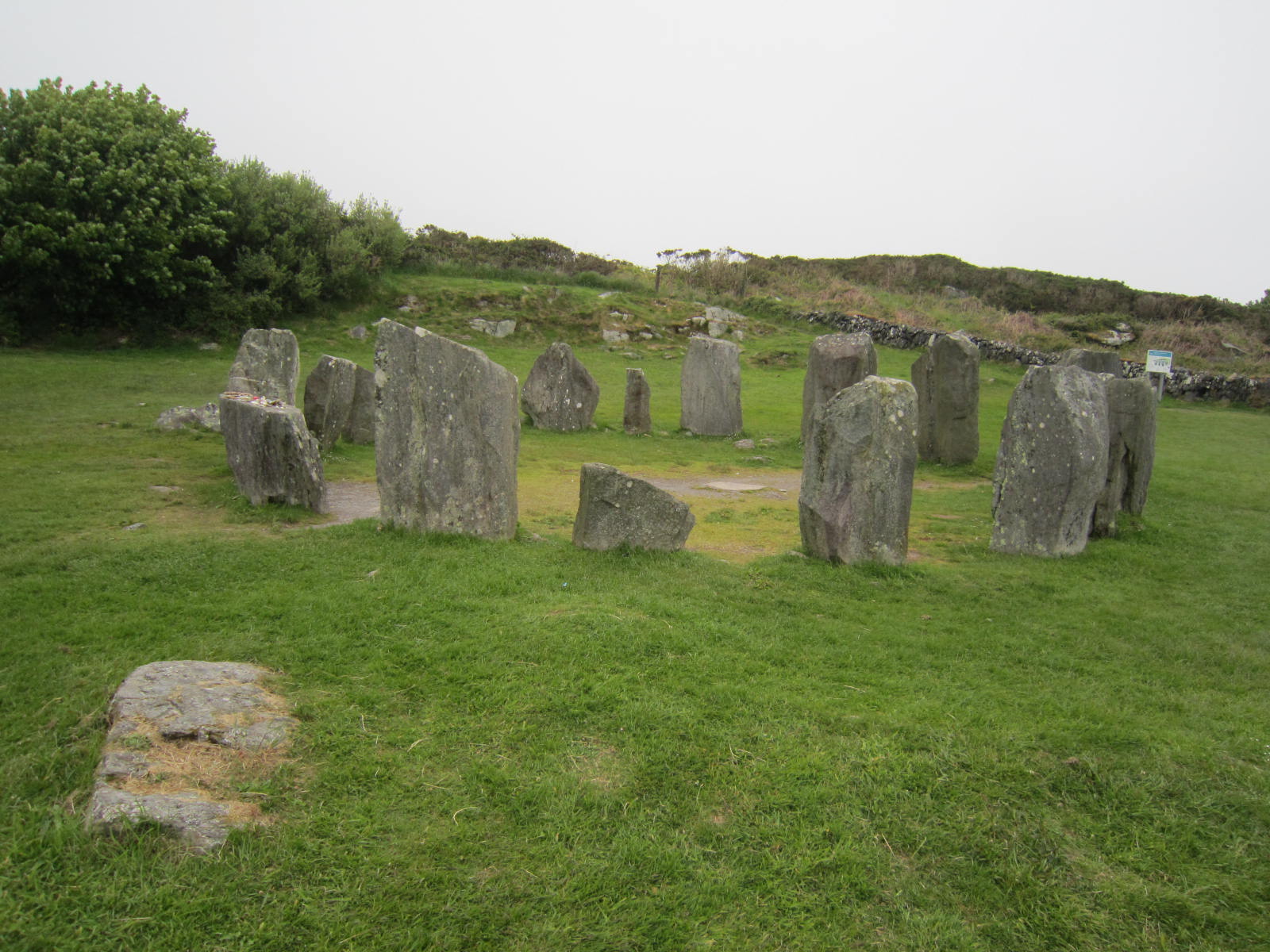 This place had interested me from afar. I didn’t intend to use a stone circle in The Prince of Glencurragh, but this one happened to sit along the travel trajectory and, despite several earlier trips to Ireland, I had never actually visited a stone circle.
This place had interested me from afar. I didn’t intend to use a stone circle in The Prince of Glencurragh, but this one happened to sit along the travel trajectory and, despite several earlier trips to Ireland, I had never actually visited a stone circle.
I wonder if everyone who visits them secretly hopes to have some kind of mystical experience? Perhaps not of “Outlander” proportions where the novel’s heroine is transported back 200 years, but at least some kind of physical or spiritual sensation. I wonder how many actually do? For me there was just the simple thrill of being there, touching something so old and at one time sacred, and imagining the people upon whose footsteps I walked.
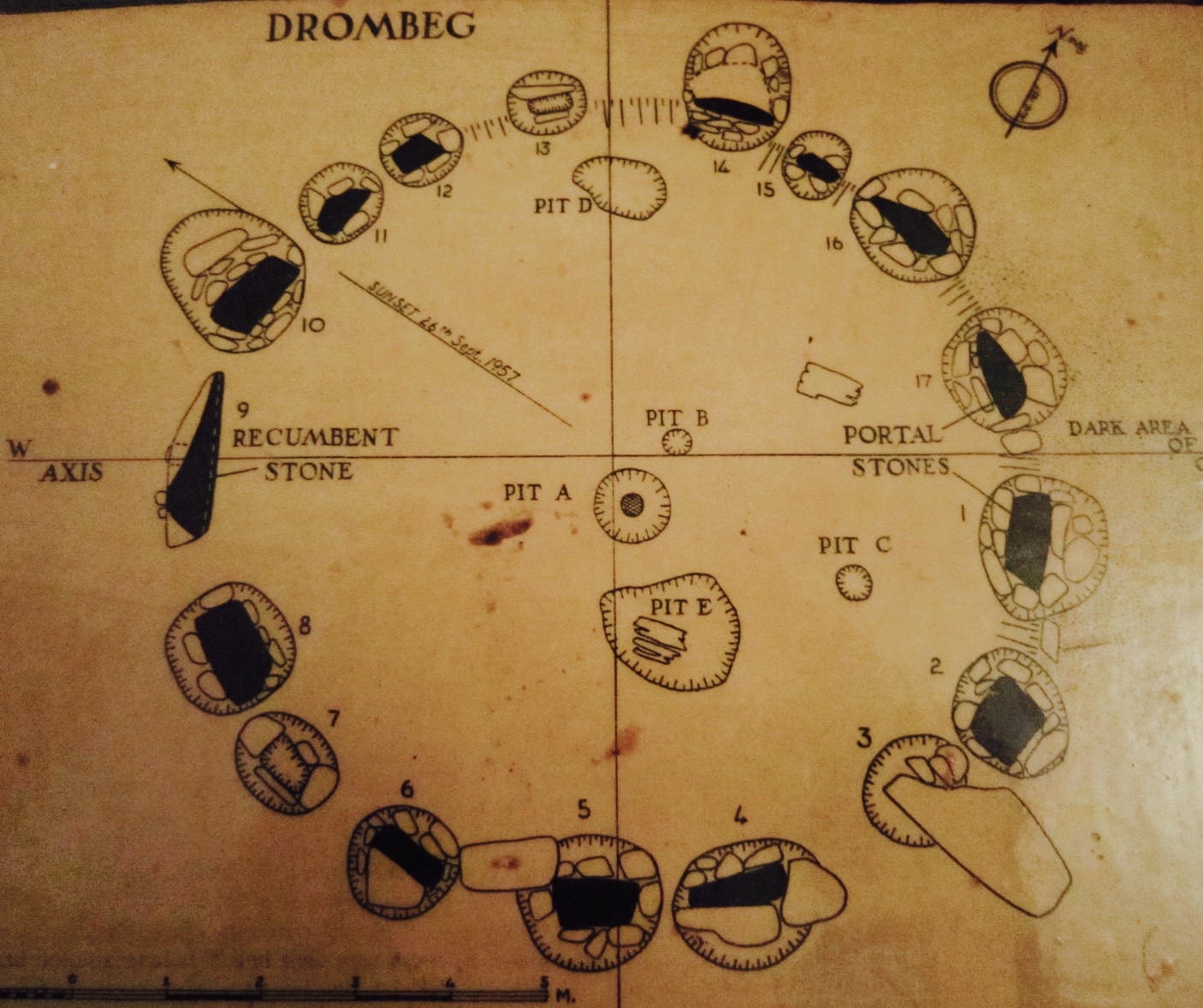 Also known as “The Druid’s Altar,” archaeologists say this 17-stone circle was in use 1100 to 800 BC. The stones slope toward its famous recumbent stone that seems to align with the winter solstice. Depressions and a cooking area (fulacht fiadh) may have been in use until the 5th century AD.
Also known as “The Druid’s Altar,” archaeologists say this 17-stone circle was in use 1100 to 800 BC. The stones slope toward its famous recumbent stone that seems to align with the winter solstice. Depressions and a cooking area (fulacht fiadh) may have been in use until the 5th century AD.
But I’ve got news for archaeologists: visitors to this site are using it still, based on the tokens and offerings they leave behind. Countless prayers must have been uttered here, and it feels almost intimate, the circle small and cloaked within a soft Irish mist. We were there in June, but had we been there at sunset in December, I’m sure we would have heard the spirits singing…

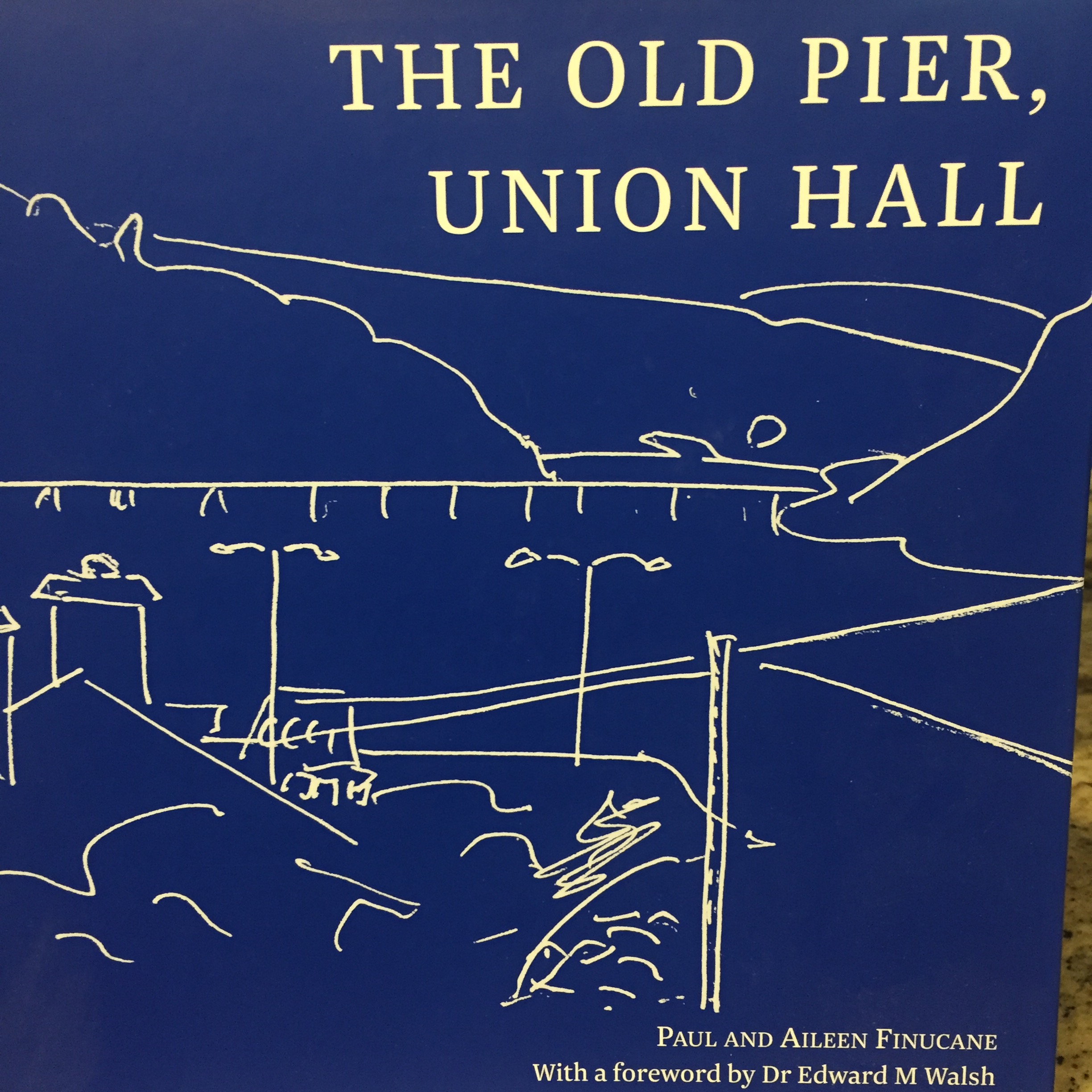 From there we passed Glandore where we would later eat a spectacular dinner at a waterfront restaurant, and Union Hall where I saw the view of the harbor that has enchanted people for ages (and is captured so creatively by the artists in the book, The Old Pier, Union Hall, by Paul and Aileen Finucane).
From there we passed Glandore where we would later eat a spectacular dinner at a waterfront restaurant, and Union Hall where I saw the view of the harbor that has enchanted people for ages (and is captured so creatively by the artists in the book, The Old Pier, Union Hall, by Paul and Aileen Finucane).
But my destination now was Knockdrum Fort, a few miles farther west. Knockdrum is one of Ireland’s many Iron Age stone ring forts, but this one was reconstructed in the 19th century. It has massive stone walls four to five feet high, arranged in a ring to provide protection as well as a 360 view of the surrounding area. Historians say that while it looks like a defensive fort, its purpose may have been sacred instead. The standing boulder just inside the entrance is inscribed with a large cross.
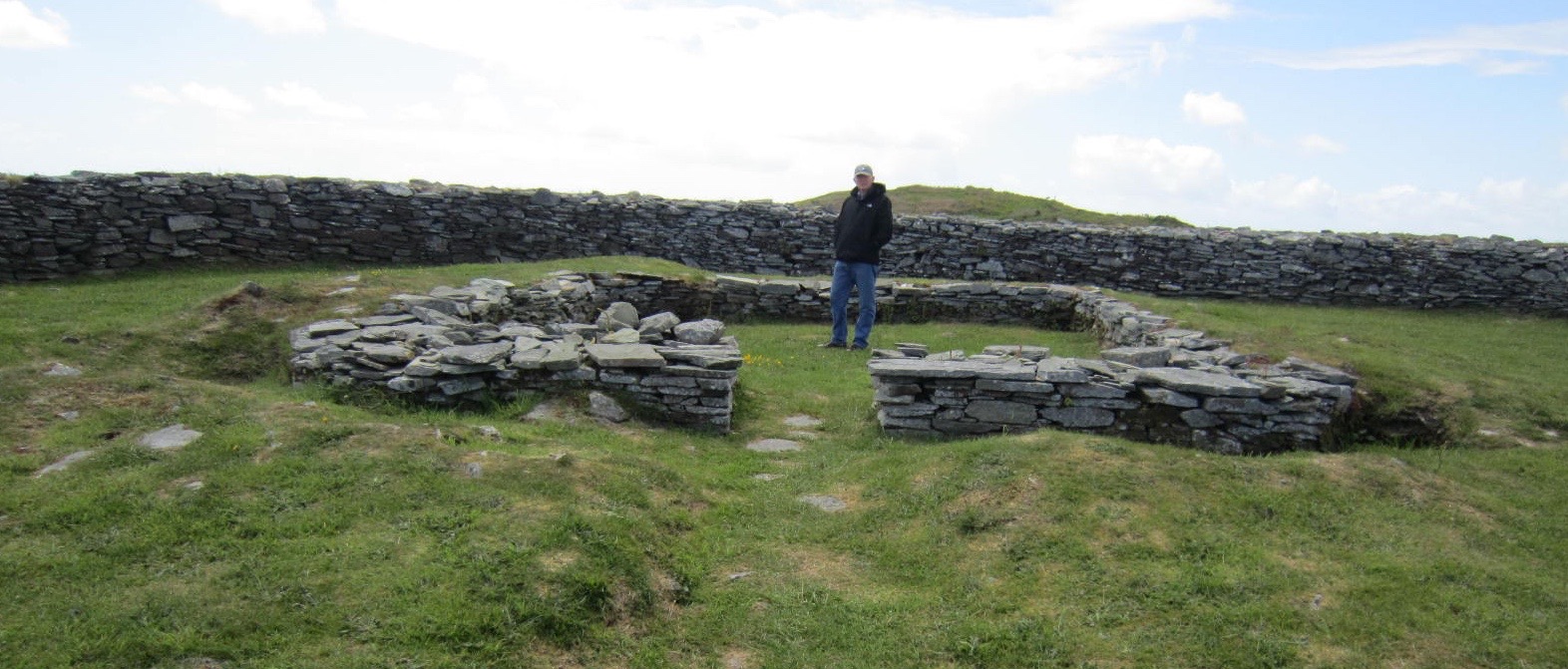
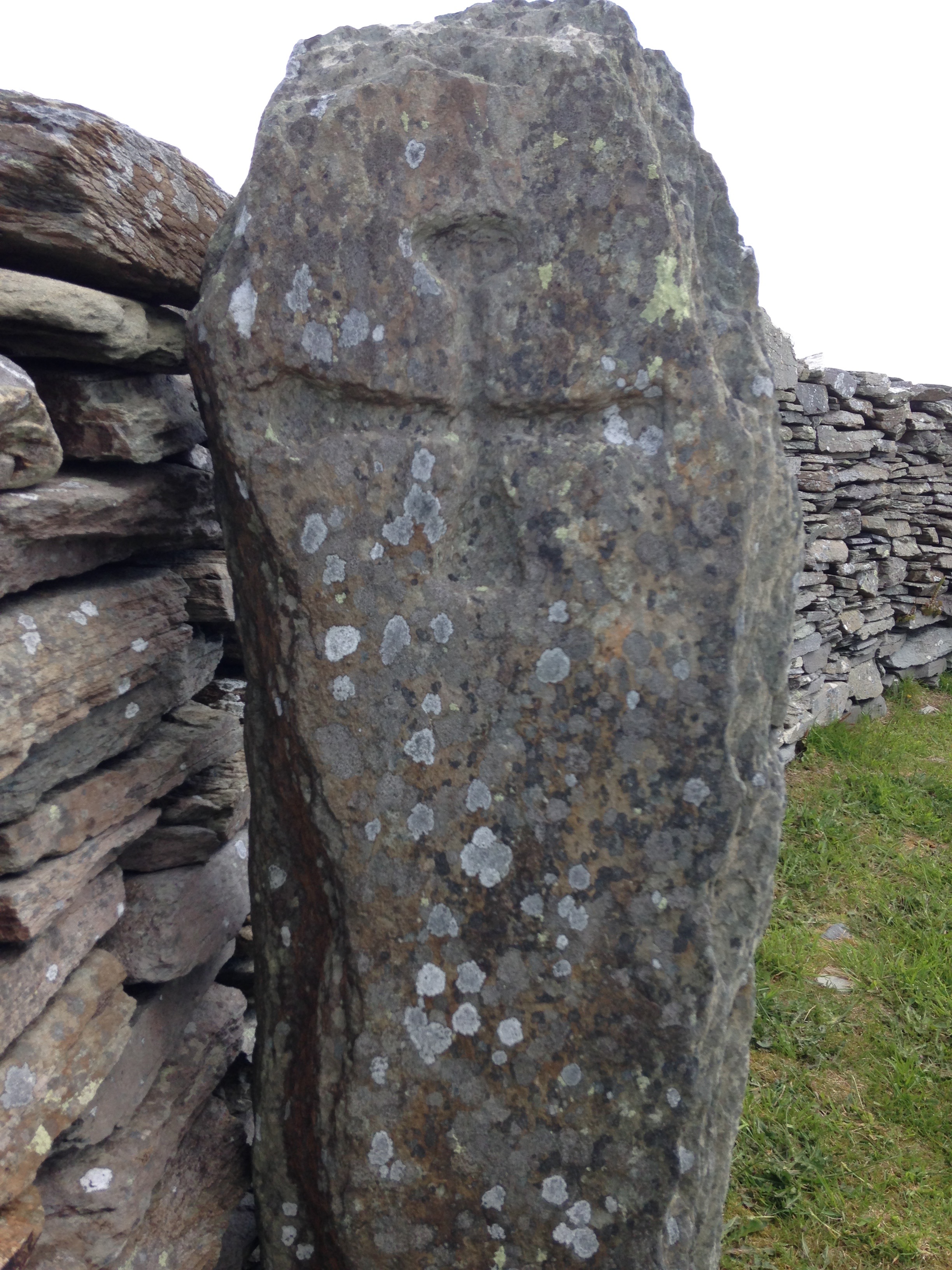 Through my research I learned the fort had a souterrain with three chambers cut from solid stone, one having a fireplace and flue. One source said the underground passage went all the way down to the sea.
Through my research I learned the fort had a souterrain with three chambers cut from solid stone, one having a fireplace and flue. One source said the underground passage went all the way down to the sea.
If this was so, I would indeed plan to use this site for a scene in my book. On paper it seemed the perfect location for a pursuit, a setup, a trap, and then a wily escape through the souterrain. And this is why actual site inspection is so important for an author.
Especially for historical fiction, readers want to learn something of the history as they read, and so, while characters and their actions can be fictional, readers expect a high level of accuracy in locations and historical events. I could not portray the location truthfully and still use it in the story because it was set high on a promontory, creating an unnecessary and unrealistic difficulty for the characters. And, if the souterrain was used for the escape route, it would have been quite a long way almost straight down to the sea, with the only advantage being if you had a seaworthy vessel waiting at the bottom.
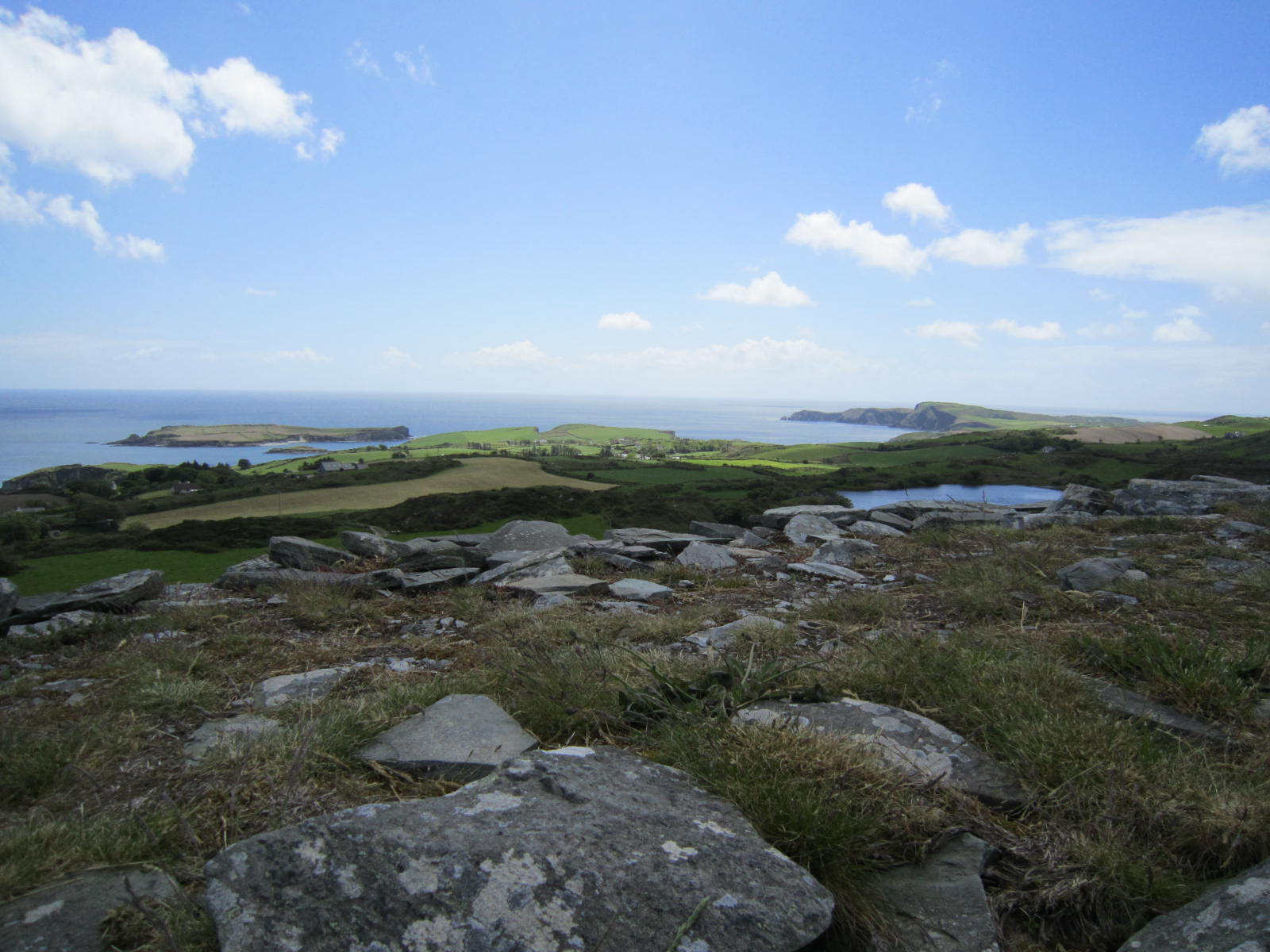
The souterrain was gated off so I could not see inside it, but I had seen enough to know that, while a remarkable site to explore, it would not serve the story well. Perhaps it will find a home in another story one day. The fort’s impressive size and appearance, and the view from all sides, is unforgettable.
Looking northeast of the site as we left it, we saw the “Five Fingers,” or rather three of them. These are megalithic stones jutting from a hill, looking like the skeletal fingers of a giant reaching for the sky—a high five for our explorations that day.
But I still needed a location for that scene in my story. And for this, the Liss Ard would serve quite nicely; coming up next week.
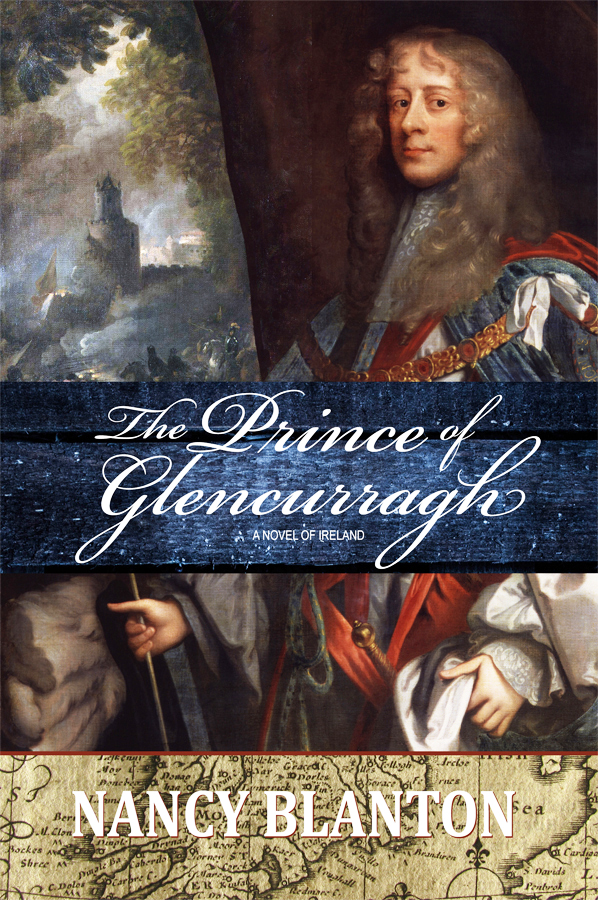 An heiress, a castle, a fortune: what could go wrong?
An heiress, a castle, a fortune: what could go wrong?
The Prince of Glencurragh is available in ebook, soft cover and hard cover from online booksellers.
Learn more and sign up for my newsletter at nancyblanton.com
https://books2read.com/u/4N1Rj6
http://www.amazon.com/Prince-Glencurragh-Novel-Ireland-ebook/dp/B01GQPYQDY/
Part 9 in a series featuring sites I visited in Ireland while researching my second novel, The Prince of Glencurragh. See previous posts listed at the end. I first discovered Coppinger’s Court as a notation on a West Cork tour map. I was seeking a route that my characters in The Prince of Glencurragh would travel from Timoleague to Clonakilty and west along the coast to Baltimore. I wondered if it might become a stopping place along their way, but instead the manor house was so dramatic it inspired another scene altogether.
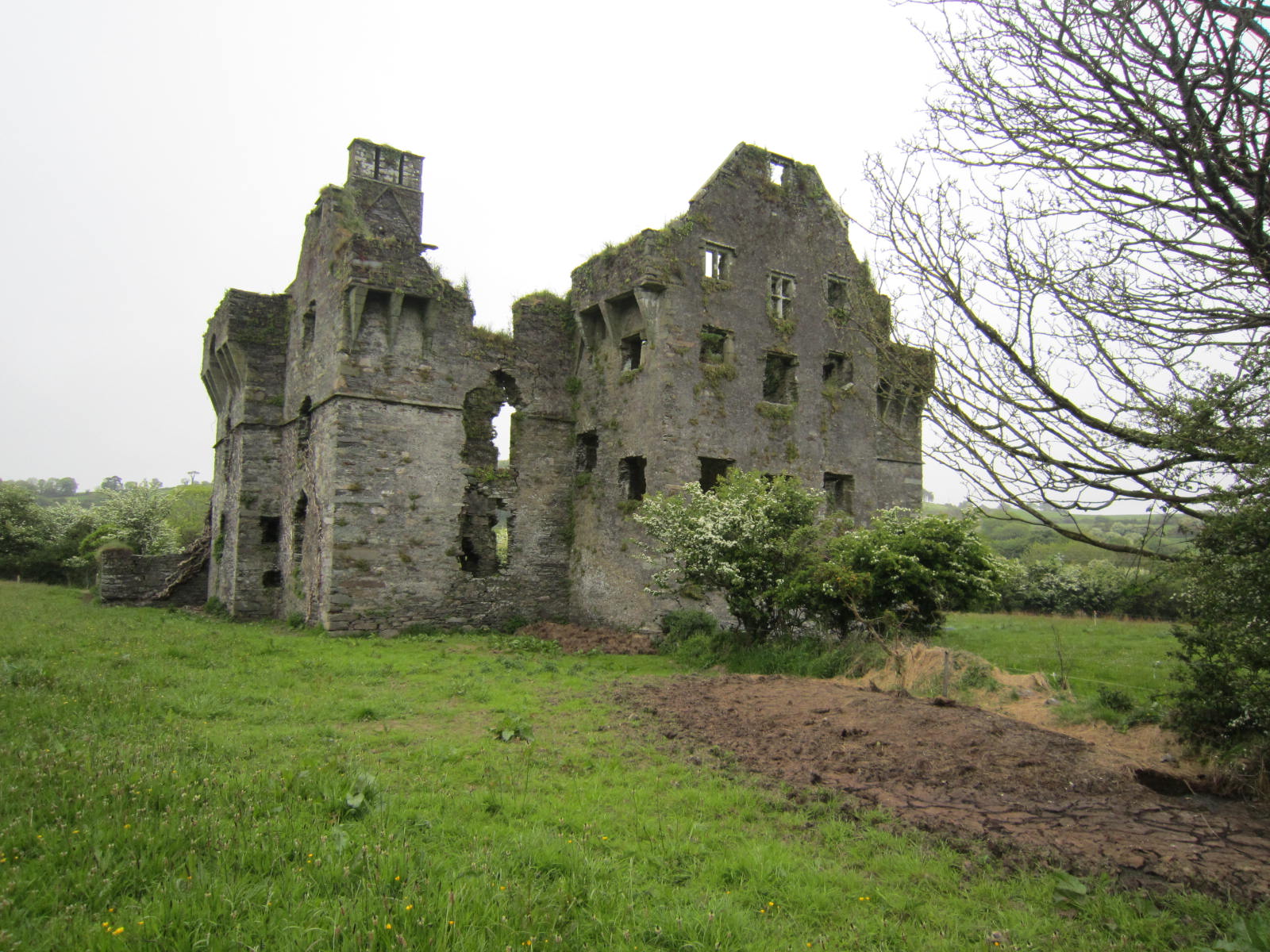 Coppinger’s Court, also known as Ballyvireen, is located along the Glandore road about two miles west of Rosscarbery. Described as a fortified manor house in the Elizabethan style, the structure has three wings off of a central court, creating nine gables, and each exterior wall has large mullioned windows that would have ensured good natural light.
Coppinger’s Court, also known as Ballyvireen, is located along the Glandore road about two miles west of Rosscarbery. Described as a fortified manor house in the Elizabethan style, the structure has three wings off of a central court, creating nine gables, and each exterior wall has large mullioned windows that would have ensured good natural light.
Considered a place of opulence in its day, the house was said to have been “the finest house ever built in West Cork,” and is credited with having “a chimney for every month, a door for every week, and a window for every day of the year.”
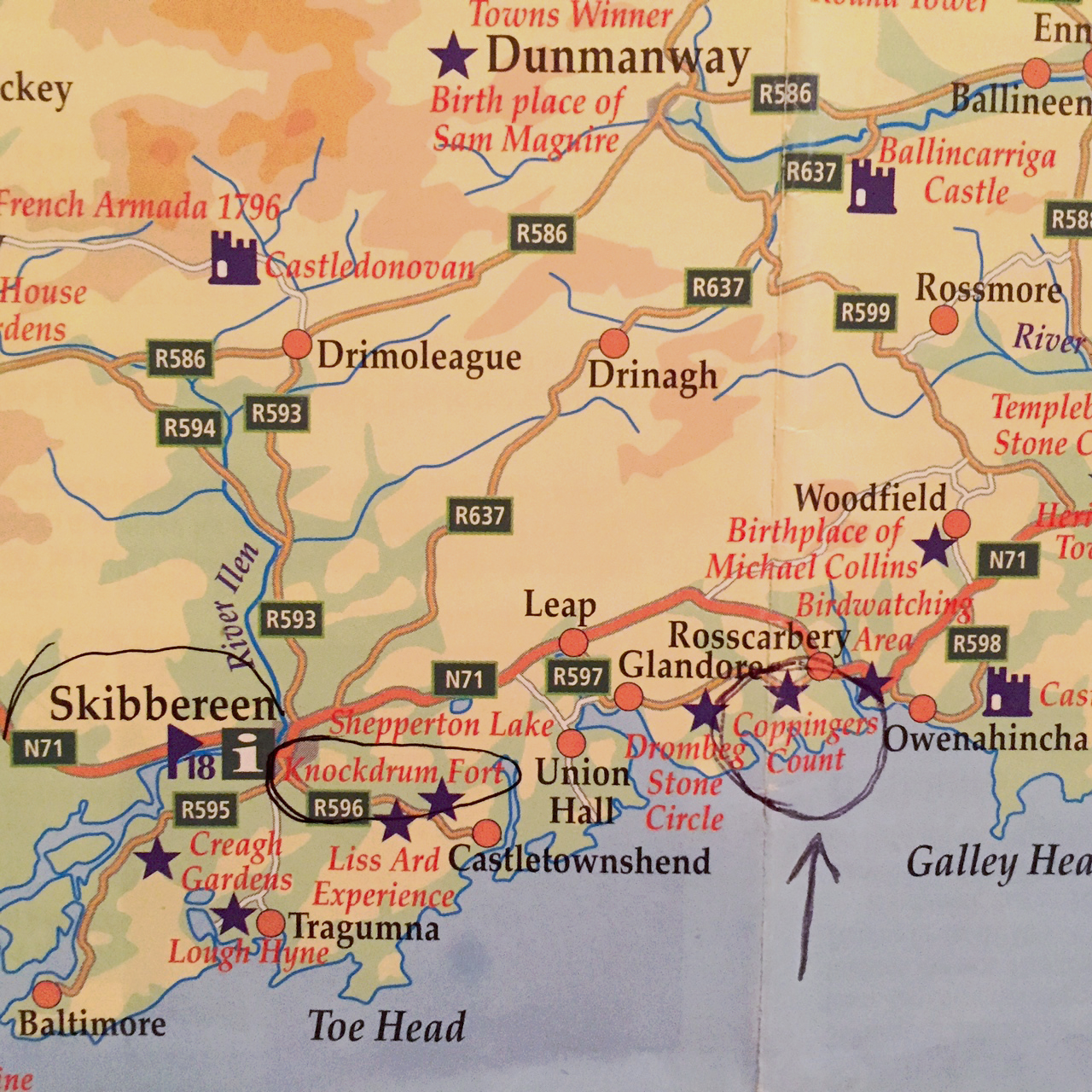 With a description like that, I had to see it. And I already knew it would become the model for the fictitious Rathmore House, the seaside home of the Earl of Barrymore located near the town of Baltimore.
With a description like that, I had to see it. And I already knew it would become the model for the fictitious Rathmore House, the seaside home of the Earl of Barrymore located near the town of Baltimore.
In The Prince of Glencurragh, Faolán Burke, his abducted/intended bride, and accomplices are rushing across Ireland’s south coast toward Baltimore. There they must meet the Earl of Barrymore who has promised to negotiate the marriage settlement. The story takes place in 1634, just three years after the town of Baltimore has been devastated by an attack and raid by Algerian pirates.
This attack was a real and violent event. Most of the town’s residents were abducted, a small number of them were ransomed, and the rest were killed, sold or used as slaves. The few survivors moved inland to Skibbereen for safety. I placed the Earl of Barrymore’s house, Rathmore, at a cove between the two settlements.
 And I soon discovered a close and perhaps sinister connection between Coppinger’s Court and the town of Baltimore, centered on the builder of the great house, Sir Walter Coppinger. Sir Walter took pride in his Viking bloodline, and descended from a mercantile family well known in Cork for centuries:
And I soon discovered a close and perhaps sinister connection between Coppinger’s Court and the town of Baltimore, centered on the builder of the great house, Sir Walter Coppinger. Sir Walter took pride in his Viking bloodline, and descended from a mercantile family well known in Cork for centuries:
“In 1319 Stephen Coppinger was mayor of the city, and several of his descendants held this position as well as becoming bailiffs and sheriffs of Cork. The Coppingers remained Roman Catholic and could therefore only afford to build a relatively modest residence at Glenville, of two storeys and five bays fronted by a semi-circular courtyard with a gate at either end.” ~ The Irish Aesthete
Sir Walter, however, was far from modest. He was a businessman, lawyer, landowner, and moneylender, who acquired many of his properties from borrowers who defaulted on their loans. Several sources support his reputation for ruthlessness, and perhaps unscrupulousness.
“Sir Walter Coppinger is remembered, probably wrongly, as an awful despot who lorded it over the district, hanging anyone who disagreed with him from a gallows on a gable end of the Court.” ~ Abandoned Ireland
Sir Walter wished to own Baltimore for its castle and properties, and lucrative pilchard industry. He was involved in legal battles for ownership, but in 1610 he and other claimants agreed to lease the town to English settlers for 21 years. By the end of the lease, Coppinger had brought a case before the king’s Star Chamber, claiming the town as his own and asking to evict the English settlers. But he grew frustrated when the chamber members were reluctant to decide the case, and reluctant to evict prosperous families who had made improvements to the properties. And then came the pirates.
“There is no concrete evidence that Coppinger had any role in organising the Algerine raid of 1631. But it conveniently removed the only obstacle to his total control of Baltimore.” ~ Des Ekin, The Stolen Village
If he was responsible, it seems Karma won in the end. Coppinger was not to benefit from his long-coveted Baltimore. The town’s vast annual pilchard run suddenly disappeared, and by 1636 he had leased out his new castle and village. Sir Walter died in 1639. Then came the great Irish rebellion of 1641. Coppinger’s Court was ransacked and burned, and then confiscated by Oliver Cromwell in 1644. By 1690 after years of disuse, the great house was on its way to becoming another beautiful ruin.
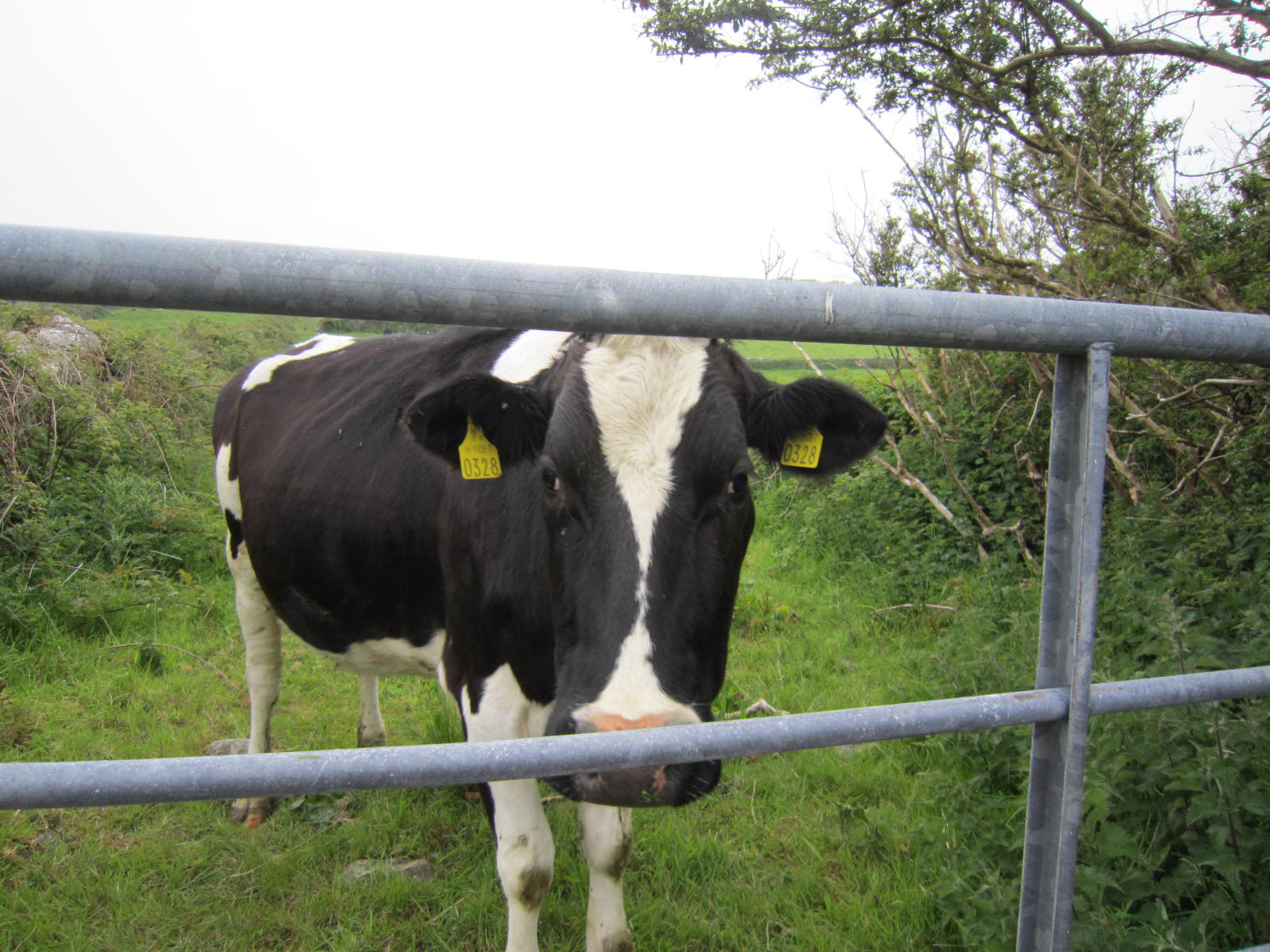
Thanks to The Irish Aesthete, Exploring West Cork by Jack Roberts, The Stolen Village by Des Ekin, abandonedireland.com,
 An heiress, a castle, a fortune: what could go wrong?
An heiress, a castle, a fortune: what could go wrong?
The Prince of Glencurragh is available in ebook, soft cover and hard cover from online booksellers.
Learn more and sign up for my newsletter at nancyblanton.com
https://books2read.com/u/4N1Rj6
http://www.amazon.com/Prince-Glencurragh-Novel-Ireland-ebook/dp/B01GQPYQDY/
Part 8 in a series featuring sites I visited in Ireland while researching my second novel, The Prince of Glencurragh. See previous posts listed at the end. Sometimes, though sand and water wash away the past, research and imagination still can resurrect it.
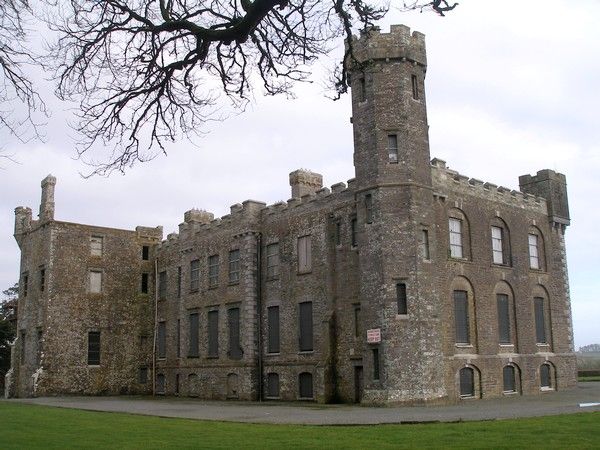
From Timoleague, Clonakilty is nearly a straight shot west along the R600. Heading south from there are rolling hills, green bluffs and marshy expanses leading toward Dunnycove Bay. On most driving and tour maps you’ll see a notation for Castlefreke.
Built by Randall Oge Barry in the 15th century, the fort was lost to the English after the Battle of Kinsale, was besieged and later burned during the Rebellion of 1641. A tower house was built on the site in 1780, which was remodeled in 1820, burned down in 1910, and at the time of my visit it was being remodeled as an event venue. However we did not visit Castlefreke itself, because it was not my destination. Instead, I wished to see Rathbarry Castle, the Red Strand, and just a little farther west, Coppinger’s Court.
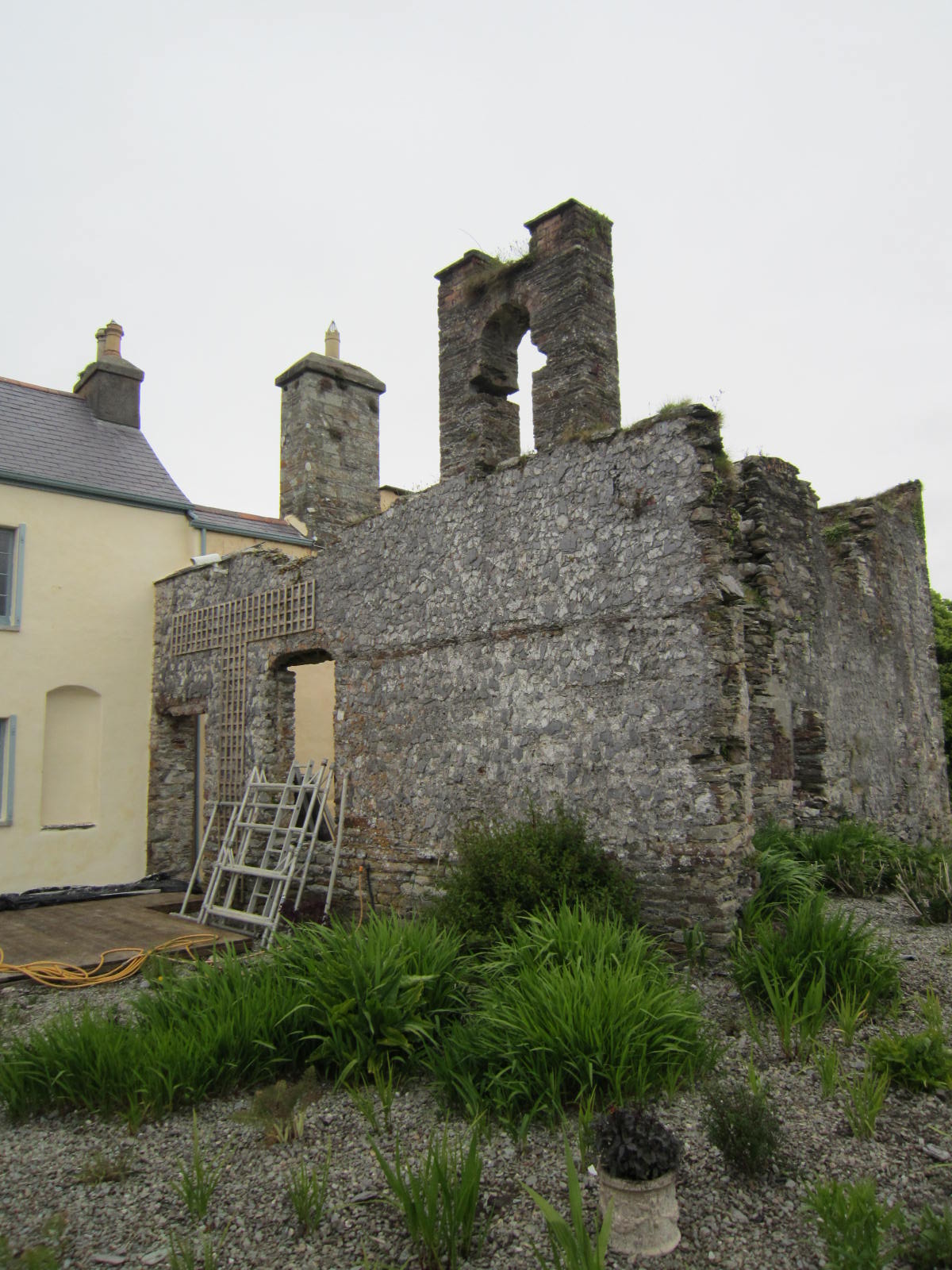
Featuring characters from the Barry family in The Prince of Glencurragh, I sought locations where they might have met or slept. I was to find little remaining of the castle, but enough to stir my imagination, and even more so, the illuminate larger forces that had been in play in the region.
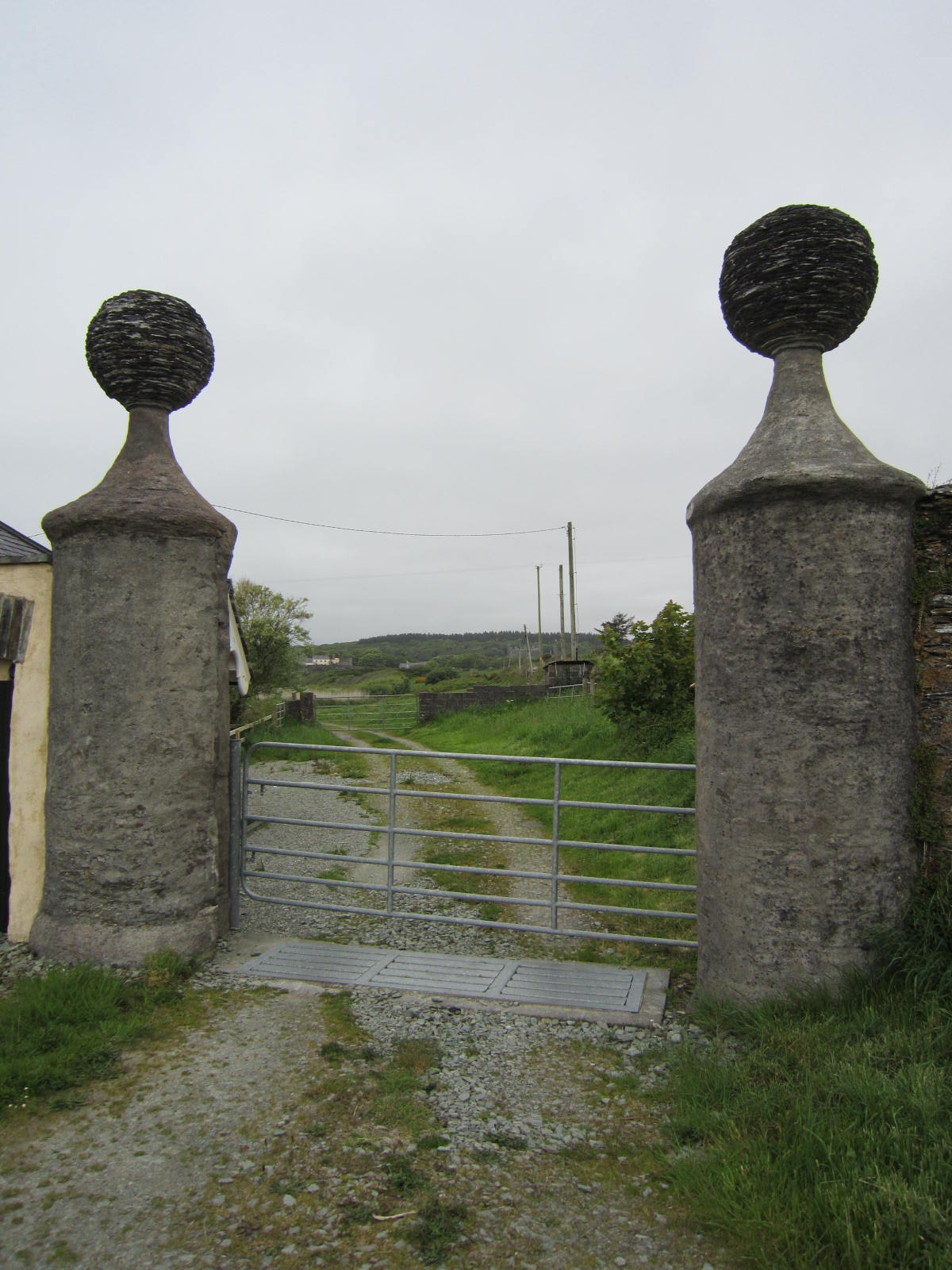
Thanks to my friends Eddie and Teresa, who introduced me to their friend Pat Hogan, I was able to visit and learn much about Rathbarry, and it became a landmark in the book, near the cottage of the mysterious healer Pol-Liam.
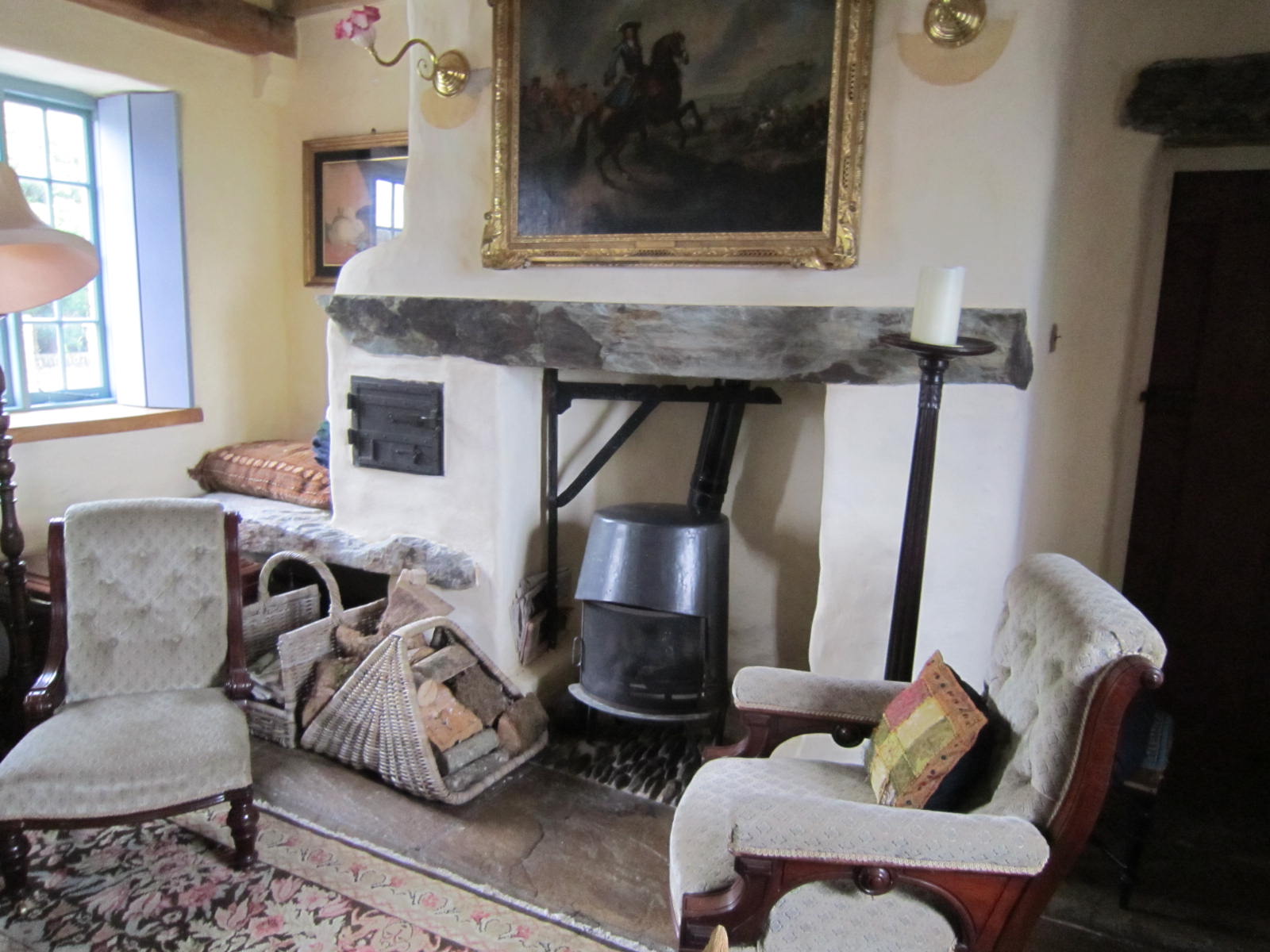 The castle Rathbarry existed on the site of what is now Castlefreke, bearing the family name of Freke for the current owners. Far out on the roadway, the gateposts marking the entrance to the castle grounds with their large spherical tops were said to be true remnants of the 17th century. Just one wall of the ancient stables and carriage house remained, and a new stable house had been built within it remodeled as a private residence. We were treated to a peek inside this structure to get a feel for what home life was like there.
The castle Rathbarry existed on the site of what is now Castlefreke, bearing the family name of Freke for the current owners. Far out on the roadway, the gateposts marking the entrance to the castle grounds with their large spherical tops were said to be true remnants of the 17th century. Just one wall of the ancient stables and carriage house remained, and a new stable house had been built within it remodeled as a private residence. We were treated to a peek inside this structure to get a feel for what home life was like there.
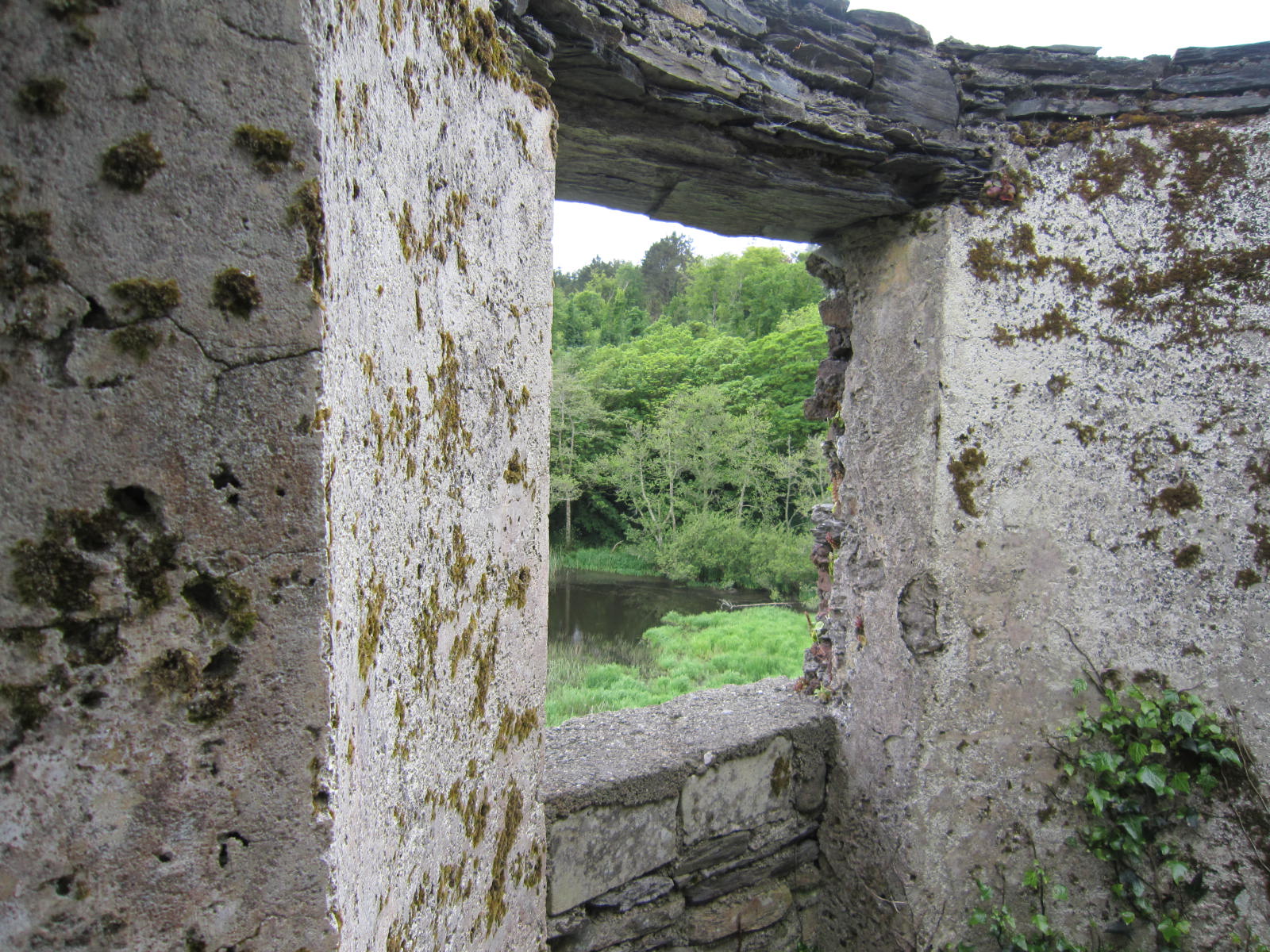 From the upper wall of the ruin, crumbling stone stairs led down to an ancient watergate, a stone passage leading directly from the castle to the water, where boats would have come to deliver food and supplies. But, except for a small, enclosed pond, there was no water. From the top of the steps I could see the bay, maybe half a mile distant. How, I wondered, could the castle have been served from such a distance?
From the upper wall of the ruin, crumbling stone stairs led down to an ancient watergate, a stone passage leading directly from the castle to the water, where boats would have come to deliver food and supplies. But, except for a small, enclosed pond, there was no water. From the top of the steps I could see the bay, maybe half a mile distant. How, I wondered, could the castle have been served from such a distance?
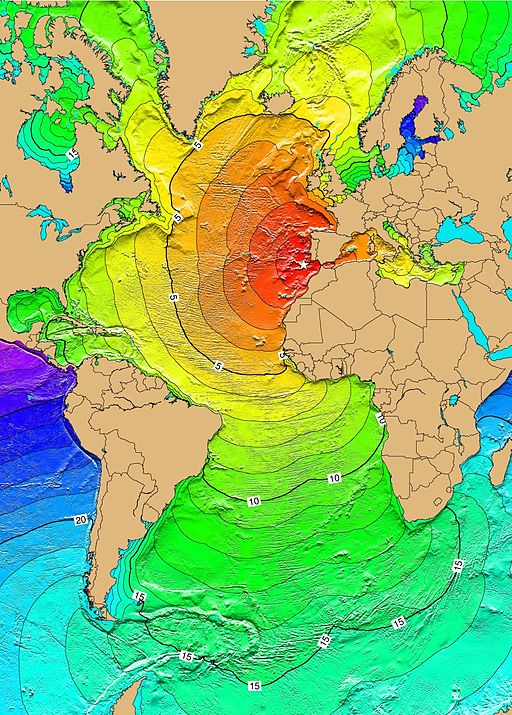
As Mr. Hogan reminded me, the landscape had changed dramatically since the 17th century, and events at the global level could have affected Ireland’s coastlines. In fact, in 1755 the Great Lisbon Earthquake and tsunami are believed to have done so. Considered one of the deadliest earthquakes in history, it is estimated to have hit the 8.5 to 9.0 range on today’s scale of magnitude, killed thousands of people and nearly devastated Lisbon. The tsunami’s impact was far-reaching.
“Tsunamis as tall as 20 metres (66 ft) swept the coast of North Africa, and struck Martinique and Barbados across the Atlantic. A three-metre (ten-foot) tsunami hit Cornwall on the southern English coast. Galway, on the west coast of Ireland, was also hit, resulting in partial destruction of the "Spanish Arch" section of the city wall. At Kinsale, several vessels were whirled round in the harbor, and water poured into the marketplace.” ~ Charles Lyell, Principles of Geology, 1830
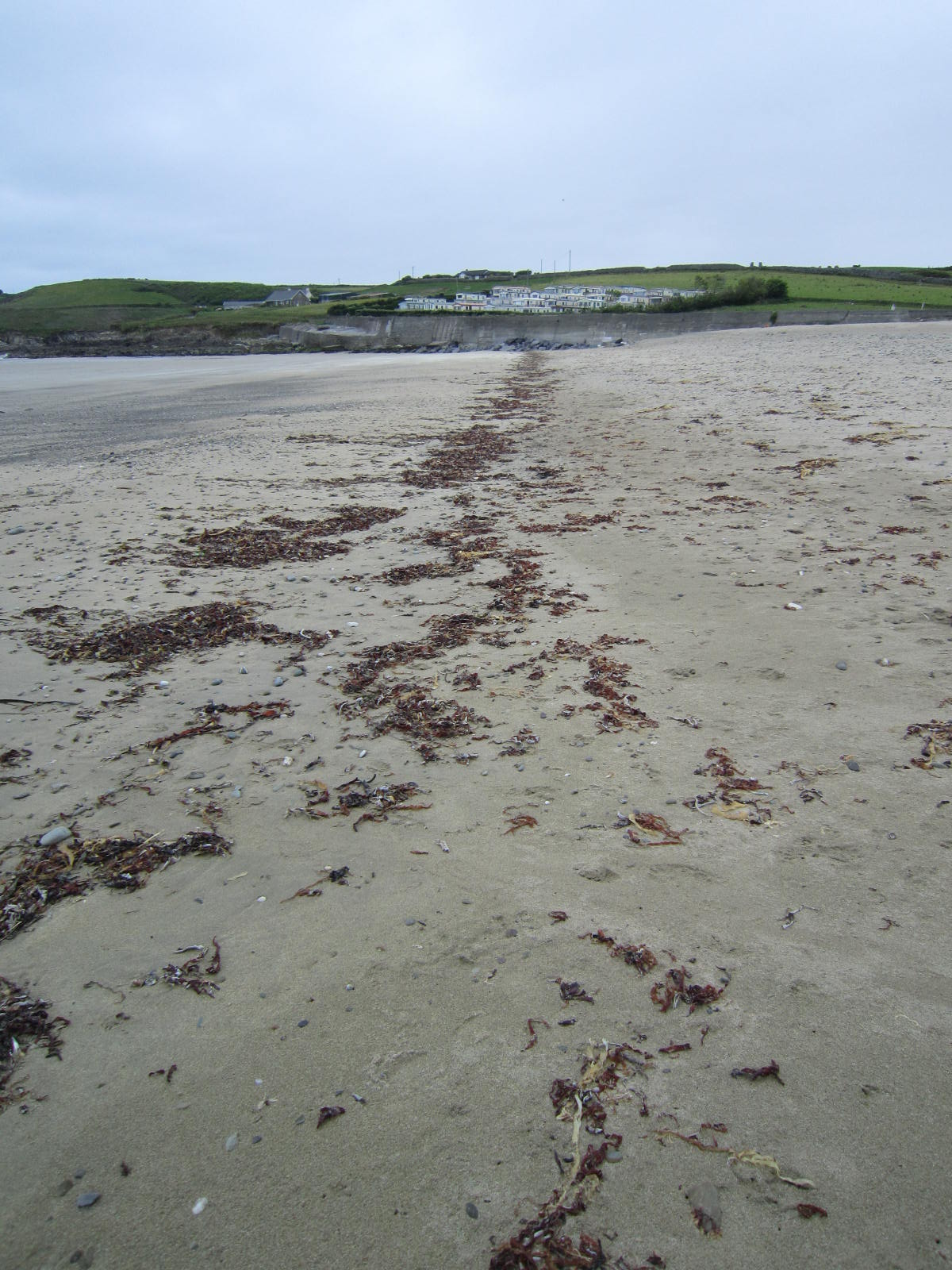 Gigantic waves were reported as well in the West Indies and Brazil. Could these environmental events have shifted sands and reshaped Ireland’s coastline? Undoubtedly.
Gigantic waves were reported as well in the West Indies and Brazil. Could these environmental events have shifted sands and reshaped Ireland’s coastline? Undoubtedly.
Almost within view of Rathbarry was another site I wished to visit: the Red Strand. Also likely to have been altered by the tsunami, this sandy beach was called “red” because the sand contained fossilized sea creatures or “calcareous matter,” which was believed to have a healing effect and also promote fertility. As late as the 19th century the sand was being collected for use in fertilizing crops some 16 miles away.
The only red I saw during my visit was in the clumps of seaweed washed ashore; still, the strand fascinates, bounded on one side by stones, and on the other by bluffs and stream. The strand and the story behind it served my imagination for a deadly scene in the book.
Next time: Coppinger’s Court.
Part 1 - Kanturk Castle
Part 2 - Rock of Cashel
Part 3 - Barryscourt
Part 4 - Ormonde Castle
Part 5 - Lismore Castle
 An heiress, a castle, a fortune: what could go wrong?
An heiress, a castle, a fortune: what could go wrong?
The Prince of Glencurragh is available in ebook, soft cover and hard cover from online booksellers.
https://books2read.com/u/4N1Rj6
http://www.amazon.com/Prince-Glencurragh-Novel-Ireland-ebook/dp/B01GQPYQDY/
Part 7 in a series featuring sites I visited in Ireland while researching my second novel, The Prince of Glencurragh. See previous post links below.
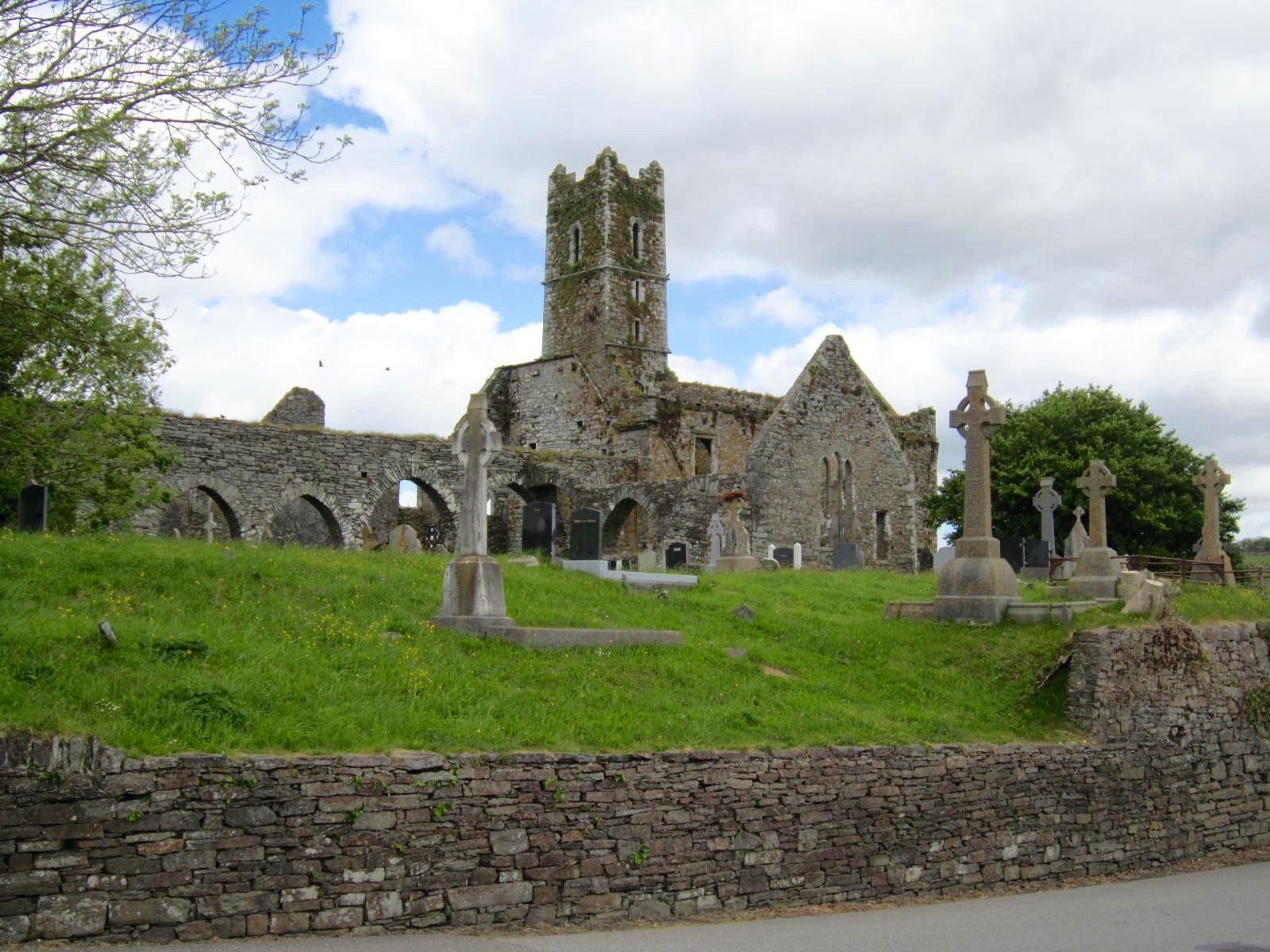 Driving south from Bandon on R602, you will arrive at the town of Timoleague in about 20 minutes, and see immediately the great landmark of Timoleague Friary. For the Prince of Glencurragh, traveling on horseback, at night and over rugged terrain, it would have taken at least three hours to reach this first stop on Faolán Burke’s path to destiny.
Driving south from Bandon on R602, you will arrive at the town of Timoleague in about 20 minutes, and see immediately the great landmark of Timoleague Friary. For the Prince of Glencurragh, traveling on horseback, at night and over rugged terrain, it would have taken at least three hours to reach this first stop on Faolán Burke’s path to destiny.
In the 17th century, local parishes were required to maintain their roads, especially in market towns. In 1634, a new act of Parliament allowed for a tax levy to cover the costs. But it would be decades before Ireland’s road systems were noted for improvements. A Scotsman traveling through Ireland in winter around 1619-1620 described his horse as “sinking to his girth” on boggy roads, his saddles and saddlebags destroyed.
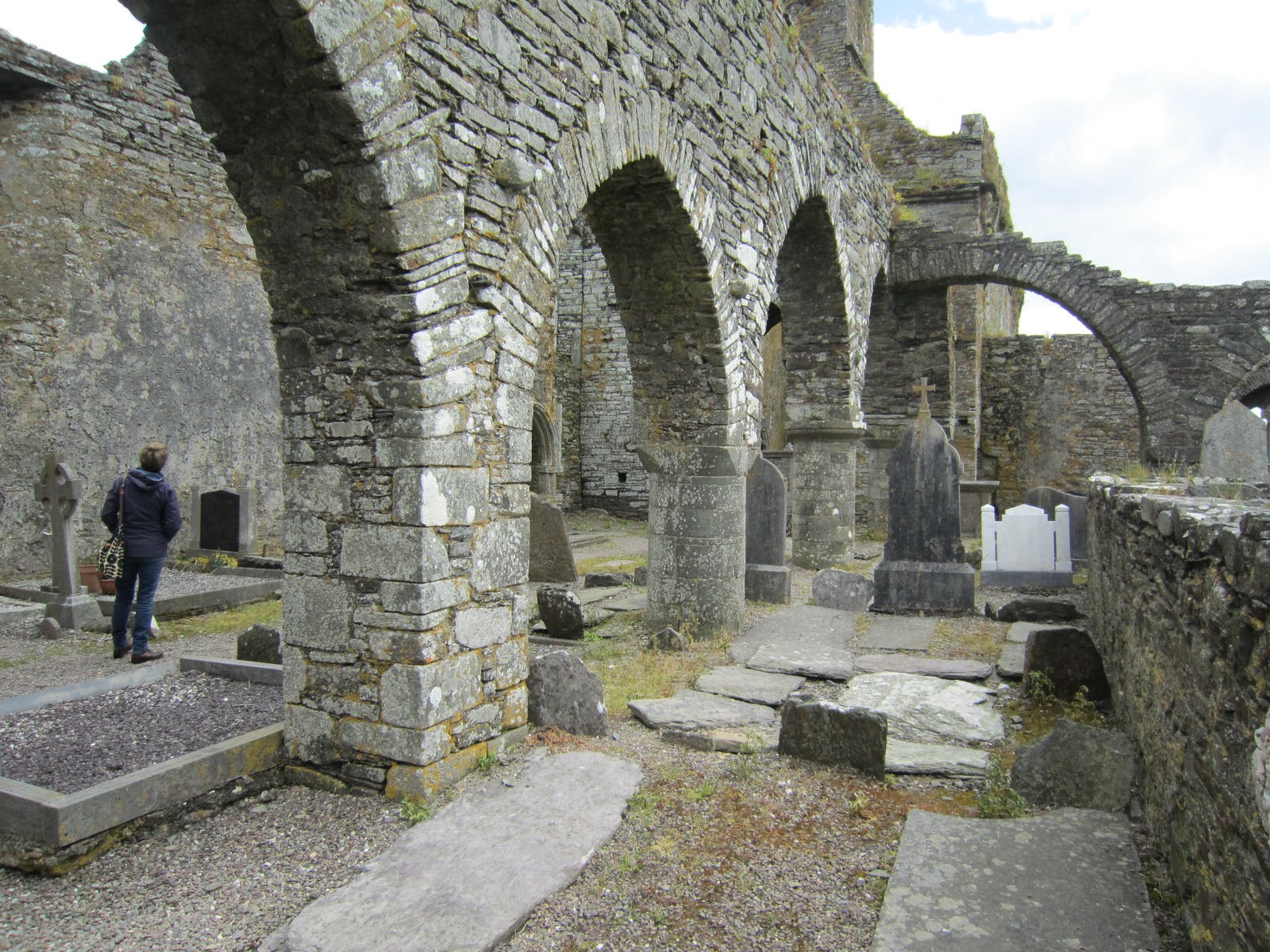 Timoleague Franciscan friary would have provided a most welcome shelter to travelers, even it its ruined state. It remains a massive and impressive structure, the walls of the various rooms still intact so that you can recognize the floor plan and how each room was used. The roof is long gone, and some sources say that parts of the structure were carted away for use in other buildings.
Timoleague Franciscan friary would have provided a most welcome shelter to travelers, even it its ruined state. It remains a massive and impressive structure, the walls of the various rooms still intact so that you can recognize the floor plan and how each room was used. The roof is long gone, and some sources say that parts of the structure were carted away for use in other buildings.
 From the mullioned window in the chorus, one would be hard-pressed to find a view more peaceful and contemplative. This is the spot where my heroine, Vivienne, considers her circumstances, having been abducted by three strange men, however benevolent they might have seemed. It’s the place where narrator Aengus recalls a treasured time with his father. And it is where he and Vivienne first realize a common bond.
From the mullioned window in the chorus, one would be hard-pressed to find a view more peaceful and contemplative. This is the spot where my heroine, Vivienne, considers her circumstances, having been abducted by three strange men, however benevolent they might have seemed. It’s the place where narrator Aengus recalls a treasured time with his father. And it is where he and Vivienne first realize a common bond.
Scenes in the book came alive for me as I entered each room and walked the same paths of monks and soldiers, and imagined conversations echoed in my mind.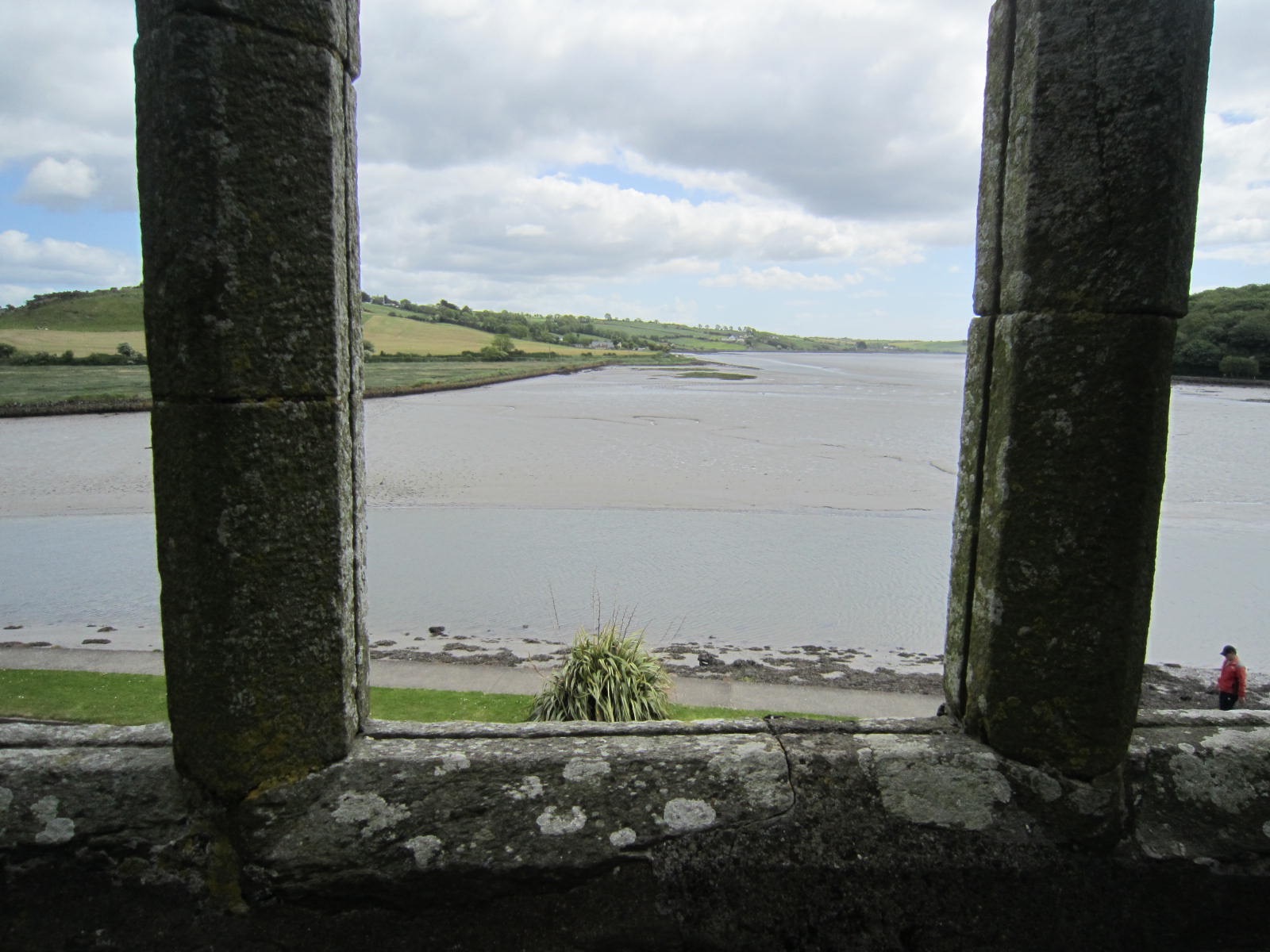
Timoleague is an Anglicization of the Irish Tigh Molaige, meaning House of Malaga for St. Malaga who is believed to have first brought beekeeping to Ireland. Foundation of the friary is attributed to the McCarthys in the 13th century, and also to William de Barry and his wife Margery de Courcy in the 14th century. Unfortunately, its position along the beautiful River Argideen and overlooking Courtmacsherry Bay made it vulnerable to Algerian pirates who sometimes cruised Ireland’s coastline in search of hostages and plunder.
 However, pirates may have seemed a minor threat compared the friary’s fate in the hands of the English. In King Henry VIII’s time, the structure was seized and as part of the Reformation the monks were dispersed. The monks returned in 1604, and then the English soldiers returned in 1612 to sack the buildings and smash all the stained glass windows. Then in 1642, English soldiers fighting the great Irish rebellion burned both the friary and town.
However, pirates may have seemed a minor threat compared the friary’s fate in the hands of the English. In King Henry VIII’s time, the structure was seized and as part of the Reformation the monks were dispersed. The monks returned in 1604, and then the English soldiers returned in 1612 to sack the buildings and smash all the stained glass windows. Then in 1642, English soldiers fighting the great Irish rebellion burned both the friary and town.
Many headstones dot the friary’s hillside, and large stone tombs in the nave are so ancient the chiseled inscriptions are no longer legible. Yet, the ruin is still an active cemetery for the local community.
Series posts:
Part 1 – Kanturk Castle Part 2 – Rock of Cashel
Part 3 – Barryscourt Part 4 – Ormonde Castle
Part 5 – Lismore Castle Part 6 - Bandon, Kilcolmen
 An heiress, a castle, a fortune: what could go wrong?
An heiress, a castle, a fortune: what could go wrong?
The Prince of Glencurragh is available in ebook, soft cover and hard cover from online booksellers.
https://books2read.com/u/4N1Rj6
http://www.amazon.com/Prince-Glencurragh-Novel-Ireland-ebook/dp/B01GQPYQDY/
See all of my books and other information at
Nancy Blanton is the award-winning author of Sharavogue, a historical novel set in 17th Century Ireland during the time of Oliver Cromwell, and in the West Indies, island of Montserrat, on Irish-owned sugar plantations. She has two more historical novels underway, as well as a non-fiction book about personal branding, Brand Yourself Royally in 8 Simple Steps. She also wrote and illustrated a children's book, The Curious Adventure of Roodle Jones, and co-authored Heaven on the Half Shell, the Story of the Pacific Northwest's Love Affair with the Oyster.

“Like reading The Three Musketeers for the first time!” —reader review of The Prince of Glencurragh